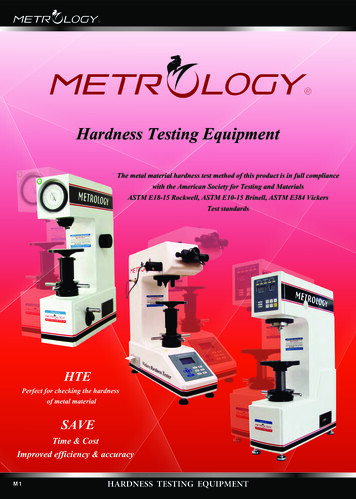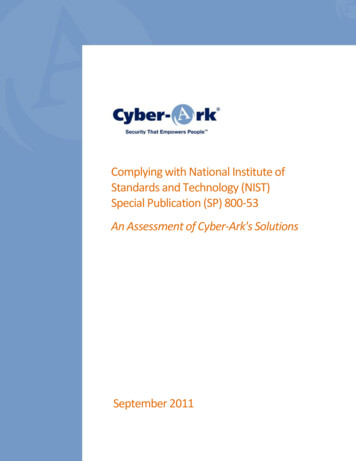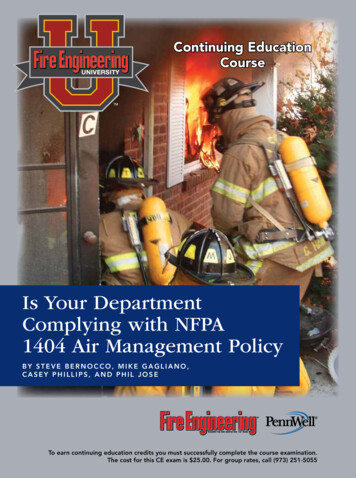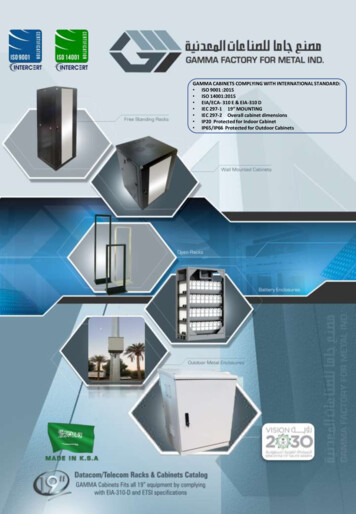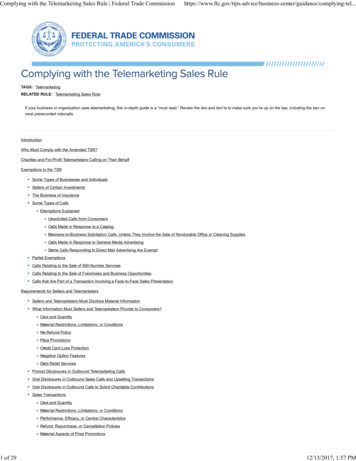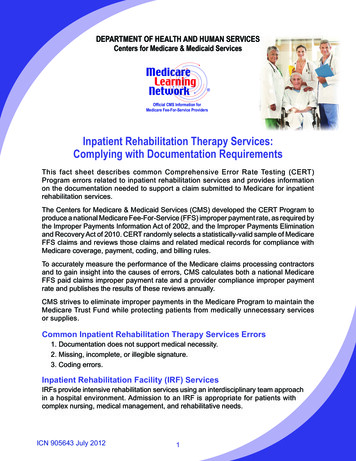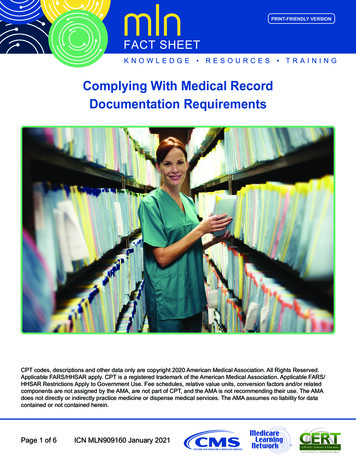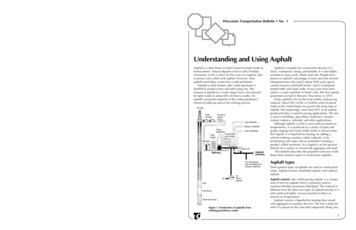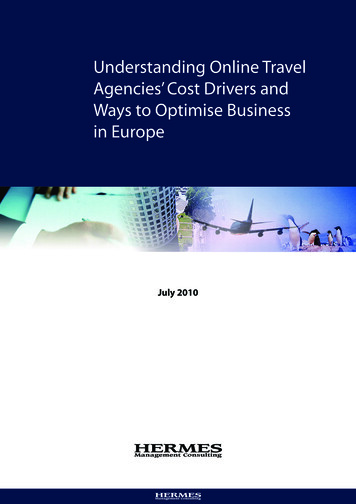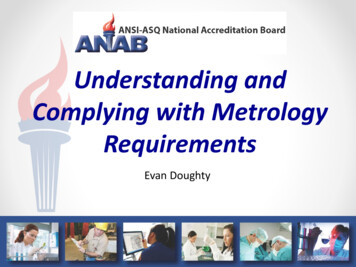
Transcription
Understanding andComplying with MetrologyRequirementsEvan Doughty
Referenced Standards Mil-Std 45662(a) ANSI/NCSL Z540-1 ISO/IEC 17025:2005 ANSI/NCSL Z540.32
So, how many car guys and gals do wehave here with us today?Yes, I could have said space orairplanes 3
Mil-Std 45662(A)4
Mil-Std 45662(A) A U.S. military standard First issued as a Mil-C in early 1960’s Requirements for establishing andrunning a Calibration “System” Rescinded 1995, replaced by ANSI/NCSLZ540-15
DefinedCalibrationConsensus StandardMeasuring and Test Equipment, MT&EMeasurement Standard Traceability Established Requirements forQMSEnvironmental ControlsCal IntervalsCal ProceduresSubcontractingHandling6
ANSI/NCSL Z540-17
ANSI/NCSL Z540-1 A U.S. national standard First issued 1994 Requirements for operating a CalibrationLaboratory (part I) Compliance of suppliers to customerrequirements (part II) Withdrawn 2007, replaced by ISO/IEC 17025(part I) and ANSI/NCSL Z540.3 (part II)8
Part I, General requirements, qualitysystem and technical How to run a lab was a carryover fromthe Mil-Spec Part II, Supplies, Services, and CustomerRequirements New approach that added the viewthat the customers had a shared risk inthe calibration of their equipment9
ISO/IEC 1702510
ISO/IEC 17025 An inter-national standard First issued 1999 (1995 as a guide) Requirements for the competence of aTesting or Calibration Laboratory Includes quality system requirements ofISO 9001 Current version is 2005, but in revision11
Contained three main pillars inestablishing competence Metrological Traceability, specifically tothe SI unit Measurement Uncertainty, the“accuracy of a calibration” Assuring the validity of results, allaccredited labs must do Interlaboratory Tests to validate theirprocesses12
ANSI/NCSL Z540.313
ANSI/NCSL Z540.3 A U.S. national standard First issued 2006 Requirements for establishing thetechnical requirements of aCalibration Lab Current version is 201314
Similar to Z540-1 except for one majordifference Introduced the idea that pass/ fail to aspecification was not sufficient Providing an accuracy ratio was notsufficient Providing measurement uncertaintywas not sufficient15
That the possibility that an item couldpass calibration but still actually be out oftolerance. Probability of False Acceptance16
Recap of the Standards Mil-Std 45662(a)Dead and buried From the 60’s replaced by Z540-1 ANSI/NCSL Z540-1On life support From the 90’s replaced by 17025 and Z540.3 ISO/IEC 17025:2005 Current international standard ANSI/NCSL Z540.3 Current U.S. national standard17
Similarities All have the requirement for a basic quality system All require good measurement technology Competent suppliers Appropriate equipment Traceability Calibration procedures Trained technical staff Calibration reports18
Key Differences Each standard tried different ways to establishaccuracy requirements 17025 focused on international confidence 17025 built in ISO9001 QMS requirements 17025 requirement for inter-laboratorycomparisons and other quality verifications 3rd party verification/ accreditation Scope of Accreditation19
Key Technical Difference Mil-Std 45662(a) used a TAR approach Z540-1 uses a TUR approach 17025 uses the approach that the lab mustcalculate measurement uncertainty (Mu) Z540.3 says the lab must maintain a notexceed a minimum probability of falseacceptance risk (PFA)20
TAR – TUR – Mu - PFA Test Accuracy Ratio Ratio of the accuracy of the standard to theaccuracy of the UUT Easy comparison Lab must maintain 4:1 ratio or better If a 4:1 is not achievable the lab must reportthe actual TAR21
TAR – TUR – Mu - PFA Test Uncertainty Ratio Similar to the 4:1 TAR ratio Introduced the realization that thecalibration process itself could influence thecalibration results Must maintain 4:1 ratio or better Not easy to calculate because the lab mustcalculate uncertainties to determine TUR22
TAR – TUR – Mu - PFA Measurement Uncertainty Shifted the focus from a test ratio tounderstanding your calibration processand the contributors to the uncertaintyor inaccuracies of the calibration Measurement Uncertainty, Mu, must bereported for each calibration test point23
Measurement Uncertainty The concept was that by knowing theMu the lab established more confidencein their measurements Left the laboratories customer theresponsibility to understanduncertainties and what it meant fortheir tests24
The Measurement Uncertainty Problem Statistics can be manipulated to make alab look better than it is or a lab thatdoes not understand their uncertaintieslook bad25
Two very different laboratories withvery different Mu could calibrate thesame item and still call it accredited aslong as they reported the uncertainties Confused Customers Created the need forCustomer Education26
TAR – TUR – Mu - PFA Probability of False Acceptance A Z540.3 lab must maintain a PFA of lessthan 2% An attempt to return to less need forcustomer education27
Key Differences When is TAR “good enough” Is 4:1 sufficient or is 10:1? TAR is very easy to determine What about TUR Do you understand the meaning of processuncertainty. Does the lab? The lab must calculate or at least understanduncertainties to determine TUR28
Key Differences ISO 17025 has two basic uncertainties Scope of Accreditation CMC Best the lab is capable of achieving Reported Measurement Uncertainty Mu The actual uncertainty of thecalibration of your piece of MT&E29
Key Differences When are 17025 uncertainties a good idea Do you understand how these uncertainties shouldbe used to determine the accuracies of your owntests? Can I just use their published scope CMCs? Simple answer is yes but think about them plusthe equipment listed on the scope as labs mayhave the same equipment but differentuncertaintiesBe an Educated Consumer30
Key Differences ANSI/NCSL Z540.3 What does PFA give me? Did they guardband or modify myequipment's tolerances? Should I worry about PFR?31
Questions to Ask Yourself Do I have a choice on what standard to use? Do I have someone imposing a requirementon me? NASA U.S. Navy Accredited 17025 lab Does that person understand the impositionin cost and time?32
Questions to Ask Yourself When do I have a choice on what standard toplace on my PO? Am I passing on traceability, am Iperforming internal calibrations? Am I the end or the traceability chain? Do I want to go and audit my calibrationproviders Confidence in my provider33
Key Audit Points 17025 Accredited labs accredited by a properlyrecognized 3rd party requires minimal or no 2nd partyaudits Audit requirements outside of 17025 such as; Specific customer requirementsoSpecial tolerancesoSpecial reporting Regulatory requirements Safety requirements34
Key Audit Points Many ISO 17025 Accredited labs are also verified forZ540-1 compliance Adds very few additional questions to the 17025checklist Since the 17025 Scope of Accreditation for anaccredited lab is published it is easy to find Z540-1compliant labs Parameters on the accredited labs scope may notbe all the tests the lab can perform35
Mil-Std 45662(A) .No reason to keep using, replaced with a good standard, Z540-1, buriedANSI/NCSL Z540-1Even though rescinded it is still widely used, TUR was easily understoodlife supportANSI/NCSL Z540.3It hasn’t been widely accepted, PFA is not well understoodISO/IEC 17025:2005Uncertainties vary greatly between providers and are not well understood36
Accreditation Certificate37
Scope of Accreditation38
39
40
Specific Thoughts Many calibration labs offer different levels of service.Other than the current ISO 17025 and Z540.3 levelsmany labs offer Z540-1 or other lower levels ofservice. Some customers just want a simple “is my caliperaccurate?”. They do not want data, actual readingsor care about how good the calibration is. Many do not understand calibration or the risk ofnot getting a good calibration.41
Specific Thoughts Risk A lab is accredited to 17025 but that does notinclude Z540-1 or Z540.3 You must perform a 2nd party audit of all otherpertinent areas Parameters on the 17025 accredited labs scopemay not be all the tests the lab can perform You’ll need to verify technical competence ofthese additional areas42
Specific Thoughts Risk Risk is a two way street. The laboratories have therisk that they must maintain proper traceability,do good technical work and give the customer thedata they require in a way they can use it. The customer must ensure they are asking the labfor what they truly need and then verify they getwhat they ask for in a way they can use it.43
Risk Ensure that you know the requirements you needto meet What level of service What deliverables, data, uncertainties, specialtraceability, special presentation Contract or Purchase Order? Ensure you are clear to your calibration provider Are there exceptions to the contract? Review what you receive or contract for44
Risk Traceability Where is the top of the traceability chain? Natural constant or consensus standards NMI (NIST) or SI Units (BIPM) Calibration accuracy and equipment tolerance TAR - TUR - Mu - PFA Assuring measurement results through PT Has the lab proven they can do quality work?45
Thank You I know that for some of you this is confusinginformation. If you have questions please ask. My contact information is:Evan Doughtyedoughty@anab.org46
Additional Training I know that for some of you this is confusing information. Internal Auditor ISO 17025- overview of accreditation Lead Assessor ISO 17025- In-depth course Practical Measurement Uncertainty Her contact information is:Caroline Trennerctrenner@anab.org47
ANSI/NCSL Z540-1. A U.S. nationalstandard First issued 1994 Requirements for operating a Calibration Laboratory (part I) Compliance of suppliers to customer requirements (part II) Withdrawn 2007, replaced by ISO/IEC 17025 (part I) and ANSI/NCSL Z540.3 (part II) 9.
